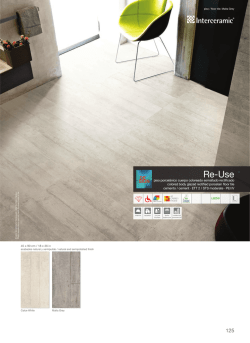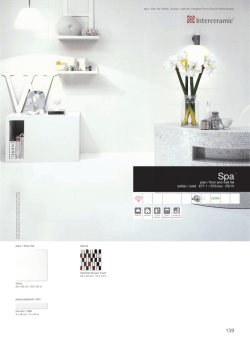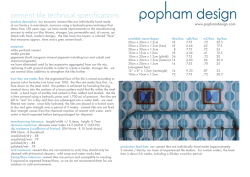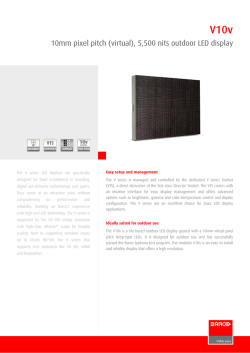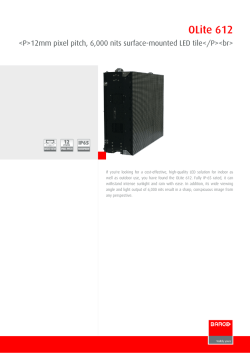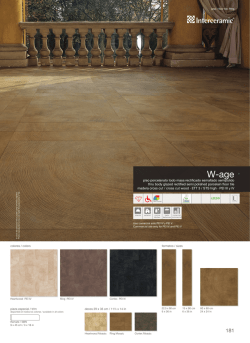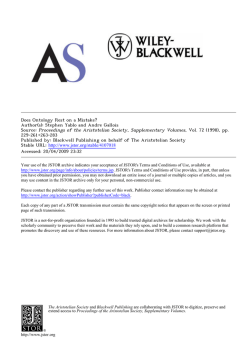
¿Cómo funciona el Sistema de Innovación del Sector - CSIC
Boletín de la Sociedad Española de Cerámica y Vidrio Vol 52, 3, 151-158, Mayo-Junio 2013 ISSN 0366-3175. eISSN 2173-0431. doi: 10.3989/cyv.202013 B O L E T I N D E L A S O C I E DA D E S PA Ñ O L A D E Cerámica y Vidrio A R T I C U L O How Does the Innovation System in the Spanish Ceramic Tile Sector Function? D. GABALDÓN-ESTEVANa,b, M.P. HEKKERTc a Department of Sociology and Anthropology, University of Valencia Institute of Innovation and Knowledge Management, INGENIO (CSIC-UPV) c Innovation Studies Group, Utrecht University b In this article we apply the functions of innovation systems framework to assess its appropriateness to characterise the innovation activity of the tile industry in Castellón. This framework is based on idea that a well functioning innovation system requires that a number of key activities take place. If this occurs innovative output is higher. Our analysis provides a deeper understanding of the role of innovation as a strategic option in a mature industry in the context of globalisation. By applying this new theoretical approach to study innovation and highlighting the functions that the system requires, we shown the constraints, inertias, challenges and opportunities that the innovation system of the tile industry in Castellón faces. The results also show that the functional approach allows higher flexibility in order to recognise and analyse the opportunities and constraints that a given innovation system presents. Keywords: innovation systems; system functions; tile industry. ¿Cómo funciona el Sistema de Innovación del Sector Cerámico Español? En este artículo utilizamos el análisis funcional de los sistemas de innovación para estimar su utilidad en la caracterización de la actividad innovadora en el sector cerámico de Castellón. El análisis funcional parte de la premisa de que para que un sistema de innovación funcione se requiere que ciertas actividades clave tengan lugar, cuando esto ocurre, el resultado de las innovaciones será mayor. Nuestro análisis proporciona un mejor entendimiento del papel de las innovaciones como opción estratégica en el caso de una industria consolidada y en el contexto de la globalización. Al utilizar esta nueva perspectiva teórica al estudio de la innovación, subrayando las funciones que el sistema requiere que sean cubiertas, mostramos las limitaciones, inercias, retos y oportunidades que se le plantean al sistema de innovación de la cerámica de Castellón. Los resultados también muestran que la perspectiva funcional permite una mayor flexibilidad a la hora de reconocer y analizar las oportunidades y limitaciones que se presentan en un sistema de innovación determinado. Palabras clave: sistemas de innovación; análisis funcional; industria cerámica. 1. INTRODUCTION This article focuses on the innovation capacity of a mature industry, the Spanish tile sector. The need for mature industrial districts to innovate in order to survive is intensifying in an increasingly open world where trade and knowledge borders are becoming more porous. The question we analyse in this paper is the extent to which innovation is the primary strategy being used by mature industries to deal with these challenges. As many authors point out [1-3], companies do not innovate in isolation. Innovating is a process in which companies interact with each other, as well as with organisations such as universities, research centres, public administration, financial institutions and so on. Therefore, many authors explain the outcome of the innovation process by studying the innovation system in which the innovation takes place. A recent development in the innovation systems literature is to focus on the functioning of innovation systems [4-5]. The basic idea is that a well functioning innovation system requires that a number of key activities take place. If this occurs, output of innovations is higher. Many studies adopt a focus on how innovation systems function [6-7]. Most of these case studies are related to specific technological trajectories and very often focus on emerging technologies and, therefore, on the formative stage of innovation systems. In this paper we apply the functions of the innovation systems framework to assess its appropriateness to characterise innovation activity in the Spanish tile industry. The paper is organised as follows: section 2 outlines the theoretical framework of the functions of innovations systems approach; section 3 deals with the methodology; section 4 presents the analysis of the Spanish tile industry applying the functions of innovation system conceptual framework. Finally, section 5 presents the main results, suggests areas for further research and offers some recommendations for policy makers and decision makers. 151 07_cerámicayvidrio_52-3(47-11).indd 151 26/6/13 14:32:31 D. GABALDÓN-ESTEVAN, M.P. HEKKERT 2. THE FUNCTIONAL ANALYSIS OF INNOVATION SYSTEMS There are different approaches to innovation that interlink agents and institutions (see [8] for a revision). If the main goal of an innovation system is the development, diffusion and utilisation of innovations [9], the analysis of the degree to which these goals are fulfilled can be assessed by analysing the system functions. Functions´ analysis derives from the technological innovation systems and sectoral innovation systems approaches, and lists of functions have been developed in the literature [3, 5, 10]. The six functions that we consider being most relevant for our analysis of the Tile Innovation System (TIS) and which are taken from Johnson [9] are: i) Knowledge development and diffusion, as most activities regarding new developments and innovations are related to knowledge (acquisition, diffusion, organisation, etc.), this function accounts for what type of knowledge is considered to be the most relevant in a sector, how varied is its knowledge base, and where its evolution is leading a particular industry; ii) Influence on the direction of search, the new developments in knowledge, the new regulations, and the changes to markets or competitors, are all factors that affect the activities in sectors, in terms of the way they perform their activities, or the range of activities they perform; iii) Entrepreneurial experimentation, in order to avoid sector stagnation, new initiatives (by existing companies or new entrants) are required; iv) Market evolution and competition, in the performance of any sector new products or designs, new regulations (or lack of them) and the performance of competitors are all factors that require a reaction from the sector in order to progress. v) Legitimation / counteracting resistance to change, like any public activity, industry activity requires a certain degree of legitimation, to achieve and maintain a legal status and be able to deliver goods and services to the community, this legitimation affects both the goods or services offered, and increasingly also the inputs needed (raw materials, energy, etc.) and the means of producing (efficiency, labour conditions, environmental impact, etc.); vi) Resource mobilisation, in order to assesses the degree to which obtaining the resources (financial capital, human capital and complementary assets) required for the performance of the sector activity is achieved, the possible threats to this provision and the need for new sources as new needs emerge. 3. METHODOLOGY In this study we partially adopt the methodology proposed by Bergek et al. [5] to analyze the Tile Innovation System. That includes i) defining the TIS in focus, ii) identifying the structural components of the TIS1, and iii) mapping the functional pattern of the TIS (section 4). The starting point of our analysis will be the product area of wall and floor ceramic tiles, an industry strongly regionally clustered at la Plana Alta; la Plana Baixa and L’Alcalaten counties in the Castellon province in Spain. The identification of the structural components of the TIS is not developed here, but we invite readers to see [11-14] for in depth descriptions of the different elements that compose the value chain and for an analysis of the different environments that compose its innovation system. 1 152 07_cerámicayvidrio_52-3(47-11).indd 152 Data availability influences the methodologies that can be used for this research and qualitative tools substitute for some of the quantitative sources proposed in Bergek et al.’s model. To complete this research 15 semi-structured interviews were carried out with representatives of the Spanish Tile Innovation System. The interviewees were chosen on the basis of their expert knowledge on the Spanish tile industry, and included managers of ceramic, electro-mechanical, glaze companies or atomisation plants; representatives of employers’ or workers’ associations; directors of research institutions responsible for R&D for the industry; academics and consultants. The interviews provided information on different aspects of industry activity and the production process. We were particularly interested in how the innovation system performs. The interviews were structured in six sections according to the scheme presented in section 2. 4. HOW DOES THE INNOVATION SYSTEM FUNCTION? In this section we discuss the functioning of the tile innovation system based on the functions introduced in section 2. 4.1. Knowledge development and diffusion We show in this section that innovation has been, and still is ongoing in most important areas of the TIS. However, much innovation comes from providers whose contributions are not specific to the Spanish TIS. Also, due to new regional and European legislation, more efforts are being made to improve energy and environmental related processes. Altogether, in this section we examine whether the TIS knowledge base is changing. The first part of this section analyses the changes in different areas of knowledge (physics, chemistry, engineering, managerial,…); the second section analyses how the new knowledge is affecting the activities along the value chain; and finally, the relevance of associations for the diffusion of knowledge is highlighted. 4.1.1. KNOWLEDGE DEVELOPMENT IN THE MAIN KNOWLEDGE AREAS In the tile industry, knowledge development has traditionally focused on the phases in the production chain, from clay extraction to packing the product, which includes the areas of materials characterisation and materials processing, and requires specially knowledge of physics, but also chemistry and engineering. The development of those knowledge for the sector has been done by the specialised research centre Instituto de Tecnología Cerámica (ITC) and the Universitat Jaume I (UJI) and is directed to codifying the industry ‘know how’ in scientific terms, to create a doctrinal body of knowledge, including the search of new materials and basic research [15]. Most of this work is been done by chemists and is focused on reducing costs and paying off capital goods investments. Chemistry is fundamental to the development of frits, glazes and colours, and is conducted mainly by the providers of these components, although in collaboration with ITC Bol. Soc. Esp. Ceram. Vidr. Vol 52. 3, 151-158, Mayo-Junio 2013. ISSN 0366-3175. eISSN 2173-0431. doi: 10.3989/cyv.202013 26/6/13 14:32:31 HOW DOES THE INNOVATION SYSTEM IN THE SPANISH CERAMIC TILE SECTOR FUNCTION? and UJI, especially in relation to setting the parameters2. The frit and glaze companies’ mastery of the development of new formulations for the tile companies means that these companies develop in-house all the designs required by the tile companies which, in return, purchase all their glaze and frit supplies from them. This applies to most tile companies since only a very few have their own laboratories specialised in these activities. In today’s industry, chemists are also one of the main players in the valorisation of waste materials and their reutilisation in the production process [16]. Engineering, either with process or chemistry specialisation, is relevant for the automation and control process3. The main contributions are in the form of adaptation of technologies to the tile industry by capital goods providers, mainly Italians. The Spanish machinery companies are mainly focused on machinery for decoration of ceramic products. Regarding organisation and sales, there is a considerable presence of business administration graduates in the industry, many of them having family links to the owner and who might be expected to take over management of their companies in the future. Other advanced services, from informatics assistance to consultancy on environmental technologies and laws, seem not to be critical, though most of those activities are externalised to service companies in collaboration with various producer associations and other institutions. 4.1.2. KNOWLEDGE DEVELOPMENT IN ACTIVITIES WITHIN THE VALUE CHAIN In the context of the basic bodies of knowledge outlined above, and the different elements of the value chain in this industry, we can highlight recent trends in new knowledge development involved in each of the different processes. As highlighted in other works [11-12] the expertise of Spanish chemists and chemical engineers has enabled the development of very specialist knowledge in the treatment of clays. For many years, this was one of the central activities in the sector, in which UJI and ITC were heavily involved. However, several interviewees reported that there is little left to be done in this area as long as the materials used remain the same. In design, different knowledge is needed. Development of bigger formats requires the joint efforts of chemist and engineers as these improvements require bigger presses but also new formulas for the clay and different arrangements for the firing process. The take off from the classic 15x15 centimetres to much bigger formats such as the very extended 60x90 centimetres and even the 100x300 centimetres tiles provided by Laminam, suggests that bigger formats are unlikely to happen. In relation to finishes, there has been a lot of development since year 2000, due to the development of presses, new glazes and the introduction of digital printing and new computer programs. It is now possible to obtain accurate imitations of natural materials (stone/wood/leather- Knowledge in chemistry is particularly relevant for clay treatment (which includes clay requirements and treatments in mines and atomisation installations, composition studies of pastes, compacting, grain size analysis, distribution, particle size, and formulations) and development and application of frits, glazes and colours. 3 Automation has brought several innovations especially regarding kilns and high tone presses, and decoration machinery, where other technologies, e.g. artificial vision for the classification of tiles, have also emerged. 2 like tiles) and other complex designs. These textures have been developed by teams of mechanical, electronic and chemical engineers and chemists at the capital goods companies for unglazed tiles, or at the frits and glaze companies for glazed tiles. Tile production has undergone long and intense efforts in terms of scientific codification and improvement, developments in single firing, monoporose and other developments which are among the most remarkable successes from applying science to the production process. In the production phase, the main knowledge required is engineering. In particular, production in the Spanish tile industry is managed mainly by chemists and chemical engineers. Firing of ceramics and glazing fusion involve complex chemical reactions at high temperature, so chemistry is relevant for ceramic tile production particularly for analysis of clays which is done in-house, and the application of frits, glaze and colours. There is room for developments in terms of new ways of fasten and other applications (e.g. photovoltaic tiles). The development of machinery for this stage of the production process is done mainly by foreign (i.e. Italian) machinery companies, and although a lot of work has been done on almost all the phases of the production chain (from clay treatment to storage, including kilns, presses, and so on) there is room for developments to mechanisations and means of meeting new demands coming from EU legislation (mainly environmental regarding energy efficiency and small particulate matter emissions). Engineering is for advances in the decoration phase and in the storage and optimisation of the whole production process. Frit, glaze and colours have also undergone major codification and scientific development efforts. However, as raw materials and new decoration demands are increasing the need for new formulations and applications, new developments are needed also in this area. 4.1.3. DIFFUSION OF KNOWLEDGE Regarding the diffusion of knowledge in the sector, the role of the technician is crucial. First, the input from ITC and UJI has been crucial for equipping graduates with the appropriate scientific and technical knowledge. Technicians were responsible for codification of production plant processes, which was the first step to their diffusion. Second, the activities of ITC and of the Asociación de Técnicos Cerámicos (ATC) promote the diffusion of knowledge among technicians, and act as platforms for continuous exchange of information and experience among them. Third, technicians promote the diffusion of knowledge across firms when they move between companies. To summarise, knowledge development in the last 25 years, particularly in chemistry and engineering, has focused on what could be considered a process of industrialising an artisan craft by means of standardising and codifying the practical knowledge, a task in which chemical engineering plays a central role. In the coming years, the efforts should be focused on reducing costs and environmental impacts, to face these challenges new scientific and technological developments are required. A second area of knowledge development includes physics, chemistry and engineering and is driven by the knowledge required for the adaptation of technologies from other industries (from atomisation to digital printing, and different firing technologies). Work is still needed in this area Bol. Soc. Esp. Ceram. Vidr. Vol 52. 3, 151-158, Mayo-Junio 2013. ISSN 0366-3175. eISSN 2173-0431. doi: 10.3989/cyv.202013 07_cerámicayvidrio_52-3(47-11).indd 153 153 26/6/13 14:32:31 D. GABALDÓN-ESTEVAN, M.P. HEKKERT which will always be open to new technologies developed in other industries. A third area involves distribution and commercialisation which has become very important due to the increased competition which is forcing product differentiation, and causing companies to adopt a more market driven approach and introduce marketing and other business related experts into their companies. 4.2. Influence on the direction of search The Spanish tile industry has achieved a high level of scientific knowledge and technical skill in the production of tiles partially due to its follower role (after Italy) in the market, which pushed the Spanish industry to compete and offer the same products at lower prices. Currently, the Spanish industry is assimilating the big drop of internal demand due to the crisis in the construction sector, and is coping with the national and international financial crisis that is directly affecting the provision of R&D resources which risks loss of their technological leadership. Optimal efficiency with the technologies available has been virtually achieved and further developments are not envisaged.4 However there are three areas where improvements would be beneficial: reductions in materials use, energy and water consumption. For instance, as suggested by our interviews, a focus on technology and ecology, which could lead to a water-free production process, could make Spanish industry very competitive.5 All the interviewees agreed that globalisation (which means new entrants to the tile industry from developing countries, opening of markets, increased materials and energy prices) does not leave space for the Spanish industry to grow. In fact, globalisation will split the Spanish tile industry [17] into those able to market a successful brand and able to compete in the global market regardless of how much they can produce; and those that will have to focus on the production of a product that is competitive in terms of quality and price. The latter group of companies will find it difficult to compete in the global market since emerging producers will be able to produce the same quality at lower cost. Consequently, companies will prefer to be in the first group and to focus on brand and market, since it is clear that there will always be somebody with lower production costs in terms of labour, materials, energy and/or environmental costs. However, not all producers will be able to adopt a successful brand oriented strategy. This vision of the industry has clear consequences for R&D strategies and for companies that try to centre all their resources either on positioning in the market through branding, or increasing their competitiveness by reducing costs. Both strategies are leading most tile companies to reduce R&D carried out in-house or to assume the indirect costs of those activities being conducted by their providers. Work is being done on improving the burners in kilns and improvements to preheating to reduce energy consumption, although measurements in real plants to assess efficiency are difficult. 5 This will provide with a Made in Spain attribute comparable to the Italian equivalent in design, and will provide a source of technological search that could lead to exportable technologies thereby making use of comparative advantage in terms of knowledge and resources (human capital, financial, institutional, cultural). 4 154 07_cerámicayvidrio_52-3(47-11).indd 154 This accounts also for the fact that new developments are usually less profitable for two main reasons. Firstly, reductions in scale make it more difficult to profit from investment in R&D. Secondly, technological improvements have made products so sophisticated [18] that it is difficult for the technicians let alone final customers to appreciate the advances and increased attributes (e.g. porcelain tiles for indoor use). In the tile industry, as is the case with many other commodities, new models are constantly launched to the market to attract consumers as part of a ‘push strategy’ but with little feedback from consumers to adapt the products offered. As a result, there is a fierce competition between brands resulting in the shortening of serials, and where imitation from non-leading firms speeds up the process. In this climate of increased competition and lower margins, providers (both of frits, glazes and colour and machinery) experience problems in transposing their R&D effort to clients via the products they acquire. As a consequence of this reduced effort on R&D, and although there are technologies in use in other industries that could be adapted for the tile industry6, in the absence of large joint research projects most developments are directed at increasing capacity (more heavier pressing, cleaner kilns) rather than looking for more complex solutions. By complex solutions we mean stronger materials that increase resistance, microwave kilns, dry treatment of clays, lower temperature processes enabled by new material mixes, resistant organic colours7 that require temperature of only 200 ºC, or new fixing mechanisms that facilitate repositioning. Also, the reduced effort on R&D would reduce the excellence in quality and production capacity that it has taken many years to achieve, which derives in reduced product and process knowledge. Environmental legislation has had a moderate effect on innovation in the ceramic tile industry. Traditionally most innovations are add-on technologies such as humid or sleeve filters or water treatments [19]. Ceramic industrial wastes have reintroduced into the production process for a long time, and since 1999 this has applied also to glaze wastes, which were more problematic to dispose because of their toxicity. The strong interconnections between tile producers and atomised clay producers make it possible to integrate small amounts of by product materials in the atomisation process [16]. Energy saving and climate protection are part of the tile industry agenda [19]. The IPCC8 is seen by most interviewees as beneficial because it promotes adoption of the best available technology in terms of energy use. Regarding Kyoto and emissions rights there is less consensus because the capabilities in twin industries (i.e. industries that develop the same activities using the same technology but in different countries) will appear different if emissions rights are calculated on a country rather than an industry basis9. Other legislation that could affect production, such as the Spanish Technical Building Code (STBC), are seen as an opportunity rather 6 Physical vapour and chemical vapour deposition, microwaves, laser, plasma injection, hydrogen, electrical heating are all considered to be cleaner technologies. 7 Organic colours currently available are polymer systems with very low physical resistance; an improvement would be to find a glass like resistance based on silicon chemistry. 8 COUNCIL DIRECTIVE 96/61/EC of 24 September 1996 concerning integrated pollution prevention and control. 9 There is a hope that emissions rights, in the long run, will adopt a similar philosophy to the IPPC, i.e. to be based on the best available technologies. Bol. Soc. Esp. Ceram. Vidr. Vol 52. 3, 151-158, Mayo-Junio 2013. ISSN 0366-3175. eISSN 2173-0431. doi: 10.3989/cyv.202013 26/6/13 14:32:31 HOW DOES THE INNOVATION SYSTEM IN THE SPANISH CERAMIC TILE SECTOR FUNCTION? than a problem because the sector has the ability easily to adapt to those new requirements, and to new demands from specific segments, such as children or the elderly, or to special characteristics, such as non-slip, anti-radiation and non-toxic. This would not require a major R&D effort from the industry as it has mastered these technologies. To summarise the direction of search, the industry can be said to be more concerned about brand and marketing strategies (market positioning, cost reductions) than strategies involving R&D and for different reasons. It is difficult to obtain fast returns from R&D investments and avoid imitation by competitors; it is also difficult to establish a joint strategy that includes all the actors in the TIS. Regarding the influence of legislation on the direction of search, much new legislation (IPCC, STBC) is easy for the industry to comply with requiring only adaptations or the inclusion of already existing technologies. Within a longer perspective, however, the industry’s ecological footprint is of serious concern for its survival in the EU. Some interviewees signalled the low disposition from the EU to promote the tile industry due to the low value added and the relatively high environmental costs in terms of mining activities, energy consumption, pollution and transport. Some also pointed to lack of interest among the EU authorities as the origin of a major crisis in this industrial activity. A new strategy is needed that could concentrate R&D efforts on finding solutions to reducing the amounts of resources required for the industry. 4.3. Entrepreneurial experimentation Since the Spanish tile industry is a mature industry, new entrepreneurial activity is not expected to stem from new entrants but from already existing companies. At the time of the interviews, the industry was facing the end of the last rise in the economic cycle. This might explain in part why interviewees see entrepreneurial activity in the sector generally as low. Below we examine individual subsectors. Atomiser firms efforts have been directed to improving the efficiency of energy consumption and co-generation due to the huge amounts of energy required in the atomising process. Also, adaptations are required to comply with the new environmental requirements to cover in areas to avoid dust pollution, and this involves high costs. As we have already pointed, tile firms are coping with an important drop on demand, this drop has cause their production to be reduced to two thirds of what it was in 2007, with consequences also on the number of employees they contract and the initiatives they are able to carry out. The special pieces enterprises were already decreasing in number at the time of the field work due to the lower margins and strong competition from new producers. In the frits, glazes and colours sector, no new enterprises have been created in the last years. However, some companies have established production units in developing countries with tile industries, to provide local supplies and technical assistance. They are also developing inks for the inject technology, but this accounts for a small part of their production. Concerning the machinery producers, the new businesses were technological enterprises producing capital goods for decoration10. Since year 2000, there has been a change from flat silk-screen to rotary decorating systems in the ceramic industry11, and even more recently the introduction of injection technology for ceramic decoration12 although this is a development technology. In relation to service enterprises, interviewees observe that in the 1990s environmental enterprises were created for water treatments and in 2000 work on air filters increased. Furniture, fair stands, consultancy, engineering, advice, informatics, design, communication, image, are all areas where there is increased activity along with the processes of control and securing (tests, delivery control, machinery calibration) which have been externalised. Logistics are becoming more important, due to the short serials and the stocks of fabrics, and use of small classification machines is increasing with the automation of warehouses. Also enterprises providing moulds and chemist additives have had an increase in the last decade on the initiative of technicians from the sector. In the very last years, though, new activities have been rare due to the economic crisis. As we have pointed out, entrepreneurial activity in the TIS is done by existing companies and not so much by new entrants. This corresponds with what is known as Schumpeter Mark II, a scenario characterised by creative accumulation where old bigger companies prevail and new companies face entrance barriers [20]. Therefore, the already established companies are the ones that carry on the attempts to cope with improvements regarding new materials (porcelain tiles), new products (façade tiles) or new technologies (inject). However, all these improvements mean increases in what companies produce (different types of clays, tiles or decorations on the tiles) which increases the portfolio of products on offer, but does not redirect search towards a new and more holistic goal such as reducing inputs and reducing the environmental impact of activities. 4.4. Market evolution and competition Regarding market evolution, a move towards branding and new niches characterises a situation where national consumption is decreasing and exports are facing challenges from the bottom, where new competitors able to sell more cheaply, and from the top, where there is a strong hegemony of Italian producers. Therefore, trying to compete on price is no longer a good strategy. The high technical developments in tile production have made it very difficult for final consumers to distinguish between different qualities and types of tiles. The strong need to differentiate products from those of competitors, especially from Italian producers, has contributed to the development of different subtypes 13 of 10 Given the need for differentiation, the new developments on decoration are additions and not substitutes, and combine to create unique designs. 11 Two techniques have been developed, flexography and hole-engraving. 12 Injection technology applied to tiles was a joing venture between engineers and technicians in the sector, and Torrecid, one of the biggest producers of frits, glazes and colours, worldwide. After developing the first inks and machines, and encouraging other enterprises to develop their own inks and machines, like Ferro, the first joint venture was dissolved. Injection technology put an end to other attempts to simulate natural surfaces by decorating before pressing which was a restrictive process. 13 This lack of rationalisation of product offerings means that some 7 different types of clay are used to produce tiles; The new adhesives mean that two types of clays will be sufficient. Bol. Soc. Esp. Ceram. Vidr. Vol 52. 3, 151-158, Mayo-Junio 2013. ISSN 0366-3175. eISSN 2173-0431. doi: 10.3989/cyv.202013 07_cerámicayvidrio_52-3(47-11).indd 155 155 26/6/13 14:32:31 D. GABALDÓN-ESTEVAN, M.P. HEKKERT tiles and a focus on characteristics that are not obvious to the end user. 14 Nationally, consumption has decreased due to the reduced building programme, which previously15 absorbed around 60 % of Spanish tile production, and 40 % of Spanish frits, glaze and colour production. This is forcing the tile industry to reposition itself in the market, to focus on exports that now accounts for about 65 % of tile production, redirect production towards alternative uses where there is still some demand, hold bigger stocks and decrease production. Other alternatives are the concentration of enterprises to achieve greater specialisation and economies of scale, greater focus on brands and control of distribution channels, where emergent economies are still weak. There is no perceived risk from alternative materials - either establish ones (carpets, wood, etc.) or new ones (e.g. silestone, glass tiles). In the case of the frits, glaze and colour companies, the decrease in national demand and the relative growth of nonenamelled porcelain tiles are reducing the home market. However, its leading position in international scene has allowed them to compensate internal contraction with an increase in exports. In the near future it is possible that delocalisation of production centres will continue towards areas where environmental restrictions are lower, labour is cheaper, energy and primary materials are more accessible. This process of delocalisation has started among the main frits, glaze and colours producers with the aim mainly of reducing transport costs. However, as Spanish tiles are present in the EU, USA and Middle East markets, and bearing in mind that an important part of new markets (such as China or Brazil) are also new producers, few efforts are being made to develop new markets, rather activity is aimed at better positioning in existing markets. It would seem that one solution would be to ignore production and focus on costs and technology, and move towards adjusting production capacity and increasing production flexibility, value added and stronger brand and distribution channel control, including design and aesthetics. As already demonstrated, Spain is weak in marketing and brand leading; thus these are areas where efforts should be focused. A good strategy might be production of ‘green’ tiles in Spain, and the emergence of synergies with the different actors involved. 4.5. Legitimation, counteracting resistance to change As a result of its long tradition and provider of wealth and employment for the region, the tile industry has benefited from good status and legitimation. However, an increase in public awareness about environmental and health issues began to emerge in the 1990s, as a result of greatly increased production, high geographical concentration of industrial activity, increased environmental regulation and control, 14 As one interviewee stated “we are selling tiles as if we were trying to sell jackets by the quality of the lining, 60 % of the qualities are blind for the customer”. 15 In the last 6 or 7 years major building activity, in some years over 800.000 homes/year, has occurred. In 2005 the number of new houses constructed in Spain was the same as in Germany, France and the United Kingdom combined. This construction delayed the cycle crisis for about 6 years; however, it is still soon to asses the full impact of the actual crisis on the industry. 156 07_cerámicayvidrio_52-3(47-11).indd 156 and an increase in other economic activities such as tourism. And, despite some efforts from producers associations to set up agreements16 with the administration that anticipated environmental laws and even with some individual efforts to implement depuration systems before it was compulsory, some interviewees recognised a lack of anticipation from both entrepreneurs associations and public administrations, about the need to adapt to new legislation, to minimise risks and to establish good channels of communication with the different social agents within the community, all of which have end up producing certain degree of refusal from the community and lawsuit against the industry. The biggest problem seems to be the mining activity where the returns to the community involved in the activity are not as evident as the return from the industrial activity (in terms of employment and taxes) and where the effect on other activities (mainly rural tourism) and the environment is greater. Since 2001 many municipalities where there is mining activity, and especially those in highly populated coastal areas, are not being so free over issuing new mining permits. Thus, mining activity is being displaced to more remote areas, increasing the costs of materials transport. EU legislation is believed to be based on in depth studies on the technologies available and the consequences of industrial activities on the environment. However, the response of the national, regional and local administrations is reactive and not coordinated. Only after the refusal from the community has arrive to media and courts that the regional administration, the one with more competences in this field, has reacted and has been able to help programming the transition of the enterprises to adapt their industries to the environmental legislation. The threat to legitimation of the industry stems from environmental pressures on the region, due to the high concentration and rapid increase in production capacity since the 1990s. The long tradition of this activity in the Castellón region increases the keenness to reach compromises between the industry and the local context. It is in the interests of the companies to invest in environmental protection measures. However, public awareness and environmental legislation are forcing the environment onto the agenda which means taking account of the environmental costs of this economic activity and forcing a convergence between economic and environmental sustainability. Direct effects are reductions in waste generation and water consumption, and search for a reduction in the weight of tiles to reduce the energy needed for their fabrication and transport. But also the extension of those environmental requirements to other producers, or at least restrictions on imports, is seen as necessary for the local industry and the global environment. However, there is an extended believe that, in the long run, industrial activities with low value added, like the tile, will not be supported by European institutions. As already mentioned, the TIS lacks the tendency to pick up on new environmental developments, a strategy pursuing a more environmental friendly industry could act as a shared objective for both technical improvement and better positioning in mature markets. 16 These agreements, as told by ANFFECC, cover storage and relocation in the industry, atmospheric emissions, water treatments, etc., in anticipation of new legislation. Some interviewees argued that legislation is too demanding and makes a balance between technology and environmental protection impossible. Bol. Soc. Esp. Ceram. Vidr. Vol 52. 3, 151-158, Mayo-Junio 2013. ISSN 0366-3175. eISSN 2173-0431. doi: 10.3989/cyv.202013 26/6/13 14:32:31 HOW DOES THE INNOVATION SYSTEM IN THE SPANISH CERAMIC TILE SECTOR FUNCTION? 4.6. Resource mobilisation The tile industry was established in the Castellón region in the beginning of the 20th century which means that the industry has had plenty of time to mobilise the resources needed to develop activities. Currently, the industry is facing several challenges. In relation to human capital, and despite the efforts made to offer degrees pertinent to the ceramic tile industry, there are some deficits. On the one hand, both vocational education in ceramics and degrees in chemistry and engineering with specialisation in ceramics are needed and valued by the industry. However, these qualifications act as a knowledge base for the acquisition of craftsmanship. High levels of learning by doing are required to master the skills required for the industry, and the link between education and in-house training should be strengthened. On the other hand, there is demand for certain qualifications, especially related to sales and marketing. Technicians are required with knowledge about information technologies for decoration and automation as well as salesman with marketing profiles, and a good knowledge of English17. It is necessary to increase sales efforts and deal with customers as well as to seek out market opportunities. Students are less interested in vocational studies like ceramics, electricity, capital goods maintenance, mechanics and electro mechanics. In terms of availability of financial capital until 2007, the economic situation was very streamlined, and interim dividends were low18, allowing funds to be invested in the industry. Before the economic crisis, the lack of financial capital was not so far been seen as a limitation19, at least not for normal functioning and investment and it seemed that new ideas and clear priorities were all that was needed in the industry. In terms of infrastructures, there were not specific requirements apart from a new rail terminal in Vila-real to connect with the Castellón harbour. The TIS counts in the region with two harbours, the one in Valencia, specialised in containers, and the one in Castellón, specialised in clay imports. Both harbours had approved plans to be extended. The TIS also has a re-gasification plant in Sagunto, done after the initiative of tile producers. And there are plans to develop more railway infrastructures within the Mediterranean corridor for European exports. On raw materials, water and energy, the situation will worsen as production increases in developing countries. Clay seems to be less problematic in terms of availability but extraction is an issue, either because of the impact in the environment, transportation costs, available infrastructure or political instability in the producing countries20. Materials such 17 Marketing forms part of several areas of study, but there is no specific degree or specific body of knowledge in marketing. Even among the big companies there is usually no marketing department. As one interviewee said “there is a need to solve the following questions: how do I have to sell the product?, what are the basic ideas that I have to have clear about the product?, what do I have to propose to the technicians and managers so the product is sold?”. 18 Interim dividends traditionally have been low due to the need to counter competition by reinvesting profits to enlarge production plants, increase production capacity and competitiveness, renew capital goods and introduce new technology. 19 Capital availability was not seen as a limitation for ceramic tile activity. However, capital could be seen as scarce if compared to those required in related hi-tech industries like the prosthetic or electromagnetic ceramics. 20 This instability in turn should favor the search for alternative materials. Until the risks materialize, and because the value added is low, the costs of research are too high. as zirconium silicate, depend on cycles21 and some companies have set up subsidiary companies to buy directly or even to buy the mines and become producers. For materials such as zinc oxide, where there is a monopoly, considerable oscillations in prices speeds up the search for new formulations that could reduce its demand. Regarding energy and water, intensively used in this industry, there is a need to increase efficiency and to reduce consumption. The capacity of the TIS to mobilise the resources needed is not a limitation to its functioning. There are always aspects that can be improved, such as education or raw materials acquisition, but the main difficulty would appear to be not what has been done in the past but what will happy in the future. A stronger orientation to marketing new services is required, particularly those related to logistics and graphic design, but also R&D and environmental consultancy. If a new approach towards greener production is to be embraced, new specialisations will be needed, new research strengths and new marketing skills. In terms of marketing, the sector has been represented by various associations and a more integrated effort is needed to coordinate the different strategies. 5. CONCLUSIONS This study provides a deeper understanding of the role of innovation as a strategic option in a mature industry in the EU in the context of globalisation. By applying a new theoretical approach to study innovation, highlighting the functions that the system requires should be fulfilled, we have shown the constraints, inertias, challenges and opportunities that the TIS faces. Regarding the Spanish tile innovation system within the industry there is the general feeling that a technological leap is not on the horizon and that the crisis is mainly related to the end of a long period of growth where construction, especially in Spain, played a major role. Other factors are related to globalisation (increasing competition in markets from new producers, delocalisation, environmental constraints and increased materials and energy prices) and a generational change in enterprises resulting in mergers. The technical innovations are generally incremental, and the technological challenges (reduction in the materials and energy consumption) are not matched by alternative production processes. Technology improvements are likely to spread rapidly to other countries and the comparative advantage will not be enough to guarantee survival. Spanish producers are highly skilled in the technological aspects of the production process and the characterisation of materials, where the Universitat Jaume I and especially the Instituto de Tecnología Cerámica have historically been of great relevance for the generation and diffusion of knowledge and the formation of human capital. There is a belief that the generation of knowledge for the industry, especially that related to frits, glazes and colours, has reached the point in the asymptotic curve where the progress achieved in relation to effort expended, is decreasing. Spanish producers are able to produce high quality products and to optimise product characteristics, but lack initiative to develop new technologies 21 Demand increases the price which in turn increases the mining activity which in the mean time reduces the price causing less profitable mines to close. Bol. Soc. Esp. Ceram. Vidr. Vol 52. 3, 151-158, Mayo-Junio 2013. ISSN 0366-3175. eISSN 2173-0431. doi: 10.3989/cyv.202013 07_cerámicayvidrio_52-3(47-11).indd 157 157 26/6/13 14:32:31 D. GABALDÓN-ESTEVAN, M.P. HEKKERT (with the exception of injection technology) or to direct markets. We can draw some conclusion from this analysis of the TIS in a period of change. There are changes to knowledge development and diffusion; codification of skills is complete. What is needed now is new developments to enable reductions in the resources (materials, water and energy) used in the industry. For the TIS to keep to the lead, a change is required in the direction of search, after a period where the main competitor (Italy) was marking the way ahead in terms of design and technology. The current competitor is China, which is imitating the strategies developed in the Spanish TIS. A new objective is needed to enable a collective response from the TIS. Change is also needed in entrepreneurial experimentation that would allow the TIS to overcome a period where success has been based on increased production, size, varieties of designs, uses, etc.; what is needed is a more radical and joint vision able to keep the TIS in technological and market leadership. A change is needed to allow the TIS to compete on value added. Such a change would allow the TIS to retain and reinforce legitimation by means of a strategy that would allow the industry to evolve according to the requirements of modern society and the demands for sustainability. And finally, a change is needed in the direction that resources are mobilised to underpin a new joint strategy. A shared strategic view that would launch a renewed innovative strategy would have a positive effect on a TIS that is lacking a clear objective. That shared strategic view might be “ecological or green tiles”, as suggested by one interviewee, and might not only group different agents within the industry but also group several different sub-strategies under one umbrella. Such a strategy would need to include a revision of all the elements in the value chain, from raw materials extraction to packaging and transportation, including firing, water and energy consumption, etc. but also market strategies. This will require new resources devoted to R&D but in the run will guarantee the TIS the privileged position of being at the forefront of a new paradigm in the tile industry. Finally, we can highlight some areas of interest for innovation system scholars. First, the functional approach allows higher flexibility in order to recognise and analyse the opportunities and constraints that a given innovation system presents. As different agents and actors can adopt different roles, it is important to retain flexibility in the recognition of the main functions rather than in categories of agents. Second, this study also demonstrates the utility of applying this approach outside the technological studies where it was developed. A sectoral system defined in terms of a product can be studied successfully by this means. 158 07_cerámicayvidrio_52-3(47-11).indd 158 REFERENCES 1. 2. 3. 4. 5. 6. 7. 8. 9. 10. 11. 12. 13. 14. 15. 16. 17. 18. 19. 20. Lundvall, B.A. User-producer relationships, national systems of innovation and internationalisation. In Foray, D. y Freeman, C. (eds.), Technology and the Wealth of Nations, Pinter Publishers (1993) Carlsson, B.; Stankiewicz, R. On the Nature, Function and Composition of Technological Systems. In Carlsson, B. (ed.) Technological systems and economic performance: the case of factory automation, Boston, Dordrecht and Londres, Kluwer Academic Publishers (1995) Edquist, C. (ed.) Systems of innovation; Technologies, Institutions, and Organizations. Pinter (1997) Hekkert, M.P.; Suurs, R.A.A.; Negro, S.O.; Kuhlmann S.; Smits, R.E.H.M. Functions of Innovation Systems: A new approach for analysing technological change. Technological Forecasting and Social Change 74 (4) 413-432 (2007) Bergek, A.; Jacobsson, S.; Carlsson, B.; Lindmark, S.; Rickne, A. Analyzing the functional dynamics of technological innovation systems: A scheme of analysis. Research Policy, 37, 407-429 (2008) Negro, S.O.; Suurs R.A.A.; Hekkert, M.P. The bumpy road of biomass gasification in the Netherlands: Explaining the rise and fall of an emerging innovation system. Technological Forecasting and Social Change 75 (1), 57-77 (2008) Alkemade, F.; Kleinschmidt, C.; Hekkert, M.P. Analysing emerging innovation systems: a functions approach to foresight. International Journal Foresight and Innovation Policy, 3 (2), 139-168 (2007) Gabaldón-Estevan, D.; Fernández-de-Lucio, I.; Molina-Morales, F.X. Sistemas Distrituales de Innovación ARBOR-Ciencia pensamiento y cultura, 188 (753), 63-73 (2012) Johnson, A. Functions in innovation systems approaches. In electronic paper at the proceeding of the Nelson and Winter conference, Aalborg (2001) Jacobsson, S.; Johnson, A. The diffusion of renewable energy technology: an analytical framework and key issues for research, Energy Policy, 28 (9), 625-640 (2000) Gabaldón-Estevan, D. El sistema distritual de innovación cerámico de Castellón. Doctoral Thesys, Universitat de València. Servei de Publicacions (2011) Tortajada-Esparza, E.; Gabaldón-Estevan, D.; Fernández-de-Lucio, I. La evolución tecnológica del distrito cerámico de Castellón: la contribución de la industria de fritas, colores y esmaltes. Bol. Soc. Esp. Ceram. V. 47(2), 57-80 (2008) Tortajada-Esparza; E.; Fernández-de-Lucio I.; Gabaldón-Estevan, D. Competitiveness and Profitability - New Challenges in the Ceramic Frit, Glaze and Colour Industry, Part 1 Interceram 57 (6), 436-439 (2008) Tortajada-Esparza; E.; Fernández-de-Lucio I.; Gabaldón-Estevan, D. Competitiveness and Profitability - New Challenges in the Ceramic Frit, Glaze and Colour Industry Part 2 Interceram 58 (1) pp. 36-39 (2009) Escardino, A. La innovación tecnológica en la industria cerámica de Castellón. Bol. Soc. Esp. Ceram. V. 40 (1), 43-51 (2001) Gabaldón, S.; López, S.; Carda, J.B. Legislación y gestión medioambiental en la producción de baldosas cerámicas. Bol. Soc. Esp. Ceram. V. 42 (4): 169-179 (2003) Meyer-Stamer, J.; Maggi, C.; Seibel, S. Upgrading in the tile industry of Italy, Spain, and Brazil: insights from cluster and value chain analysis. At Schmitz, H. (Ed.) Local enterprises in the global economy: issues of governance and upgrading. Edward Elgar. Cheltenham, United Kingdom. pp. 174-199 (2004) Flor M.L.; Oltra, M.J. Identification of innovating firms through technological innovation indicators: an application to the Spanish ceramic tile industry, Research Policy, 33, 323-36 (2004) Criado, E. Reflexiones sobre el futuro de la Industria Europea de la Cerámica, Bol. Soc. Esp. Ceram. V. 46 (1), 39-46 (2007) Schumpeter, J. A., Business Cycles. New York, McGraw-Hill (1939) Recibido: 02/12/2011 Recibida versión corregida: 18/12/2012 Aceptado: 12/04/2013 Bol. Soc. Esp. Ceram. Vidr. Vol 52. 3, 151-158, Mayo-Junio 2013. ISSN 0366-3175. eISSN 2173-0431. doi: 10.3989/cyv.202013 26/6/13 14:32:31
© Copyright 2025
